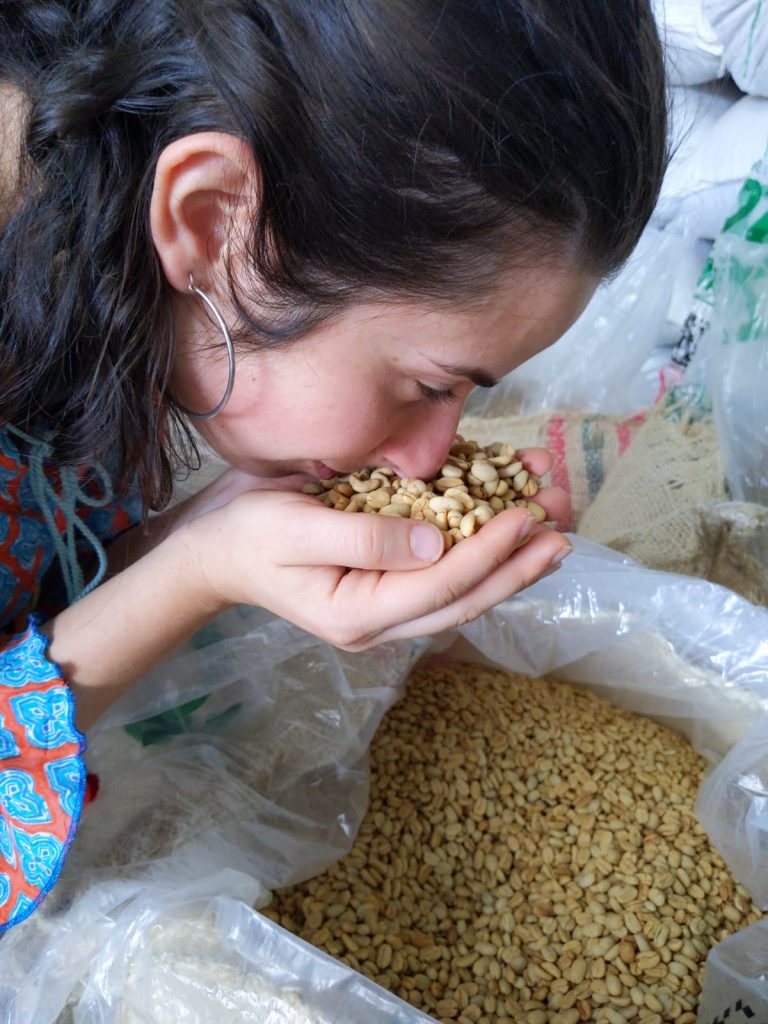Traceability is a must for our coffees, from plantation to cup. The techniques and methods of growth that are used by the farmers we import from, are a fundamental element for selecting our coffees.
In August 2019 Helena Oliviero, coffee expert and trainer of our Espresso Academy and Eleonora Bernini, export manager and granddaughter of Vasco, founder of the roastingMokaflor, embarked on a one-month journey across the Brazilian plantations. A journey to discover farms which we have been collaborating with for many years, but also to discover new areas and growers with their very unique and different coffee processing techniques.
Discovering Brazilian farmers
Sustainability, training and exchange were only some of the goals of this trip. We really wanted to get to know these farmers personally, learning about their coffee growth and processing methods as well as their working and living conditions.
During our visits we also organized coffee courses for the farmers, to improve and promote the culture and awareness from a coffee consuming country’s perspective. In fact, you might not know that Brazil prohibits the import of raw coffee into the country. This means that for those coffee growers who are not able to travel much, it’s really difficult to taste and explore different varieties of coffee from around the world.
Our journey
Brazil has a great variety of different territories mainly given by the vast geographical area the country covers. The plantations we visited are located within the regions of Caparaó (Espirito Santo), Alta Mogiana (San Paolo) and Cerrado Mineiro (Minas Gerais).
Espirito Santo
The first stop on our journey was in the state of Espirito Santo at the Sitio Pedra Roxa where we visited Fabricio Campo dall’Orto and the almost neighboring farm of Aromas do Caparaó where Flavio Sales de Freitas and his wife even hosted us for a few nights.
The two plantations are located in the area of Caparaó, famous for its beautiful landscapes made of high and almost blue-like mountains and tropical nature. Here the growth altitudes reach above 2800 meters (the Pico da Bandeira for example, is the highest peak of the Serra do Caparaó, at 2892 meters above sea level). The truly unique microclimate and Flavio’s thorough control of the nutritional balance of his plants lead to a late coffee flowering, florada. The cherries then start growing at a later point in time during the year, which therefore guarantees more hours of light to the cherry ripening.
In this area, coffee is harvested by hand, as the land’s conformation doesn’t allow any mechanical work. The producer is therefore able to select only the ripest coffee cherries, guaranteeing a superior quality. Here the plantations are rather small and only organic farming methods are used such as permaculture. This means that different plants and trees are used within the plantations to organically guarantee the wellbeing not only of the coffee plant and all those surrounding it but also that of the soil, which is crucial for the healthy growth of the coffee plants to come.
Alta Mogiana
The second stop of our journey was at O ’coffee Brazilian Estates in Alta Mogiana. This is a traditional coffee region that covers the north-east of the state of São Paulo.
The excellent natural conditions (altitude, climate and frequent rainfall) are ideal for the growth and processing of specialty coffees. This region is located on a plateau with an altitude between 800 meters and 1200 meters and is known throughout the world for the production of exceptionally great Arabica coffee.
O’Coffee is made up of seven different farms: Nossa Senhora Aparecida, São José, Santa Rita, Santa Maria, Santa Adélia, Santa Helena and Fazendinha, for a total of almost 2,000 hectares dedicated only to coffee and over seven million plants.
Cerrado Mineiro
The last stop on our journey was at the Fazenda Rio Brilhante in the Cerrado Mineiro region, within the state of Minas Gerais.
The name of the farm comes from the river that “feeds” the coffee plantations.
Over the years the Rio Brilhante Café de Origin has become one of the largest farms of the country. In the last 4 years it has won different awards for productivity and quality, including 3 times the 1st place in the Cerrado Coffee Japan quality competition, 2nd place in the Rainforest / Imaflora competition for the natural coffee category and also 3rd place in the 5th Cerrado Mineiro Region Award.
We were truly fascinated by the great importance given to the well-being of their workers. In addition to guaranteeing food and accommodation for all workers and their families, school for their children and a decent wage, sustainable cultivation practices are applied. From rainwater collection systems for plant growth, to the use of other plants for the defense against parasites and insects and natural fertilizing systems. The Fazenda Rio Brilhante follows a sustainable coffee growing model that we truly admire!













